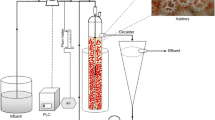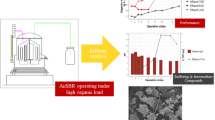Abstract
A mechanically stirred anaerobic sequencing batch reactor containing anaerobic biomass immobilized on polyurethane foam cubes, treating low-strength synthetic wastewater (500 mg COD L−1), was operated under different operational conditions to assess the removal of organic matter and sulfate. These conditions were related to fill time, defined by the following feed strategies: batch mode of 10 min, fed-batch mode of 3 h and fed-batch mode of 6 h, and COD/[SO4 2−] ratios of 1.34, 0.67, and 0.34 defined by organic matter concentration of 500 mg COD L−1 and sulfate concentrations of 373, 746, and 1,493 mg SO4 2− L−1 in the influent. Thus, nine assays were performed to investigate the influence of each of these parameters, as well as the interaction effect, on the performance of the system. The reactor operated with agitation of 400 rpm, total volume of 4.0 L, and treated 2.0 L synthetic wastewater in 8-h cycles at 30 ± 1°C. During all assays, the reactor showed operational stability in relation to the monitored variables such as COD, sulfate, sulfide, sulfite, volatile acids, bicarbonate alkalinity, and solids, thus demonstrating the potential to apply this technology to the combined removal of organic matter and sulfate. In general, the results showed that the 3-h fed-batch operation with a COD/[SO4 2−] ratio of 0.34 presented the best conditions for organic matter removal (89%). The best efficiency for sulfate removal (71%) was accomplished during the assay with a COD/[SO4 2−] ratio of 1.34 and a fill time of 6 h. It was also observed that as fill time and sulfate concentration in the influent increased, the ratio between removed sulfate load and removed organic load also increased. However, it should be pointed out that the aim of this study was not to optimize the removal of organic matter and sulfate, but rather to analyze the behavior of the reactor during the different feed strategies and applied COD/[SO4 2−] ratios, and mainly to analyze the interaction effect, an aspect that has not yet been explored in the literature for batch reactors.






Similar content being viewed by others
References
Silva, A. J., Hirasawa, J. S., Varesche, M. B., Foresti, E., & Zaiat, M. (2006). Evaluation of support materials for the immobilization of sulfate-reducing bacteria and methanogenic archaea. Anaerobe, 12, 93–98. doi:10.1016/j.anaerobe.2005.12.003.
Lens, P. N. L., Visser, A., Jansen, A. J. H., Hulshoff, P. L. W., & Lettinga, G. (1998). Biotechnological treatment of sulfate-rich wastewaters. Critical Reviews in Environmental Science and Technology, 28(1), 41–88. doi:10.1080/10643389891254160.
Ratusznei, S. M., Rodrigues, J. A. D., Camargo, E. F. M., Zaiat, M., & Borzani, W. (2000). Feasibility of a stirred anaerobic sequencing batch reactor containing immobilized biomass for wastewater treatment. Bioresource Technology, 75, 127–132. doi:10.1016/S0960-8524(00)00048-1.
Michelan, R., Zimmer, T. R., Rodrigues, J. A. D., Ratusznei, S. M., Moraes, D., & Zaiat, M., et al. (2009). Effect of impeller type and mechanical agitation on the mass transfer and power consumption aspects of ASBR operation treating synthetic wastewate. Journal of Environmental Management, 90(3), 1357–1364.
Ratusznei, S. M., Rodrigues, J. A. D., Camargo, E. F. M., Ribeiro, R., & Zaiat, M. (2003). Effects of feed strategy on the stability and efficiency of a stirred anaerobic sequential fed-batch reactor containing immobilized biomass. Bioresource Technology, 90(2), 199–205. doi:10.1016/S0960-8524(03)00113-5.
Souza, J. T., & Foresti, E. (1996). Domestic sewage treatment in the up-flow anaerobic sludge blanket – sequencing batch reactor system. Water Science and Technology, 33, 73–84.
Muthumbi, W., Boon, N., Boterdaele, R., De Vreese, I., Top, E. M., & Verstraete, W. (2001). Microbial sulfate reduction with acetate: Process performance and composition of bacterial communities in the reactor at different salinity levels. Applied Microbiology and Biotechnology, 55, 787–793. doi:10.1007/s002530100623.
APHA, AWWA, WPCF (1995). Standard methods for the examination of water and wastewater (19th ed.). Washington: American Public Health Association.
Dillalo, R., & Albertson, O. E. (1961). Volatile acids by direct titration. Journal - Water Pollution Control Federation, 3, 356–365.
Ripley, L. E., Boyle, W. C., & Converse, J. C. (1986). Improved alkalimetric monitoring for anaerobic digestor of high-strength wastes. Journal—Water Pollution Control Federation, 58, 406–411.
Holt, J. G., Krieg, N. R., Sneath, P. H. A., Staley, J. T., & Williams, S. T. (1994). Bergey’s manual of determinative bacteriology, 9th ed. Williams & Wilkins.
Rinzema, A., & Lettinga, G. (1988). Anaerobic treatment of sulfate containing waste water. In D. L. Wise (Ed), Biotreatment systems, vol III. Boca Raton, USA: CRC.
O’Flaherty, V., Colohan, S., Mullerrins, D., & Colleran, E. (1999). Effect of sulphate addition on volatile fatty acid and ethanol degradation in an anaerobic hybrid reactor. II: Microbial interactions and toxic effects. Bioresource Technology, 68, 109–120. doi:10.1016/S0960-8524(98)00146-1.
Isa, Z., Grusenmeyer, S., & Verstraete, W. (1986). Sulfate reduction relative to methane production in high-rate anaerobic digestion: microbiological aspects. Applied and Environmental Microbiology, 51(3), 580–587.
Acknowledgments
This study was supported by the Fundação de Amparo à Pesquisa do Estado de São Paulo (FAPESP—São Paulo, Brasil) and Conselho Nacional de Desenvolvimento Científico e Tecnológico (CNPq—Brasil). The authors gratefully acknowledge Dr. Baltus C. Bonse for the revision of this paper.
Author information
Authors and Affiliations
Corresponding author
Rights and permissions
About this article
Cite this article
Friedl, G.F., Mockaitis, G., Rodrigues, J.A.D. et al. AnSBBR Applied to Organic Matter and Sulfate Removal: Interaction Effect Between Feed Strategy and Cod/Sulfate Ratio. Appl Biochem Biotechnol 159, 95–109 (2009). https://doi.org/10.1007/s12010-009-8585-0
Received:
Accepted:
Published:
Issue Date:
DOI: https://doi.org/10.1007/s12010-009-8585-0




